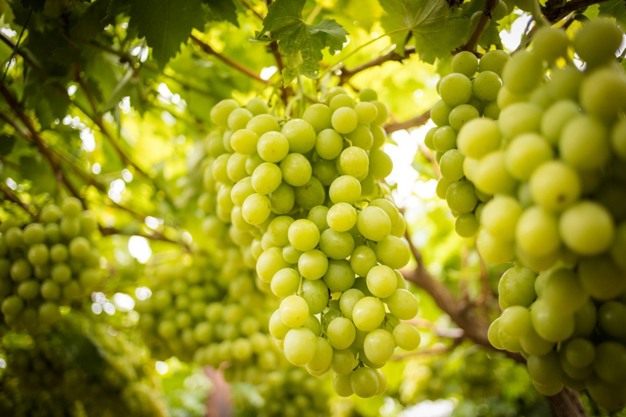Why are table grapes seeing growing consumption numbers? Rabobank's senior analyst fresh produce David Magaña has some thoughts on why.
Out of the fruits in the U.S., Magaña, who last month co-authored the company's Table Grape Update 2024: Recovering from Last Year's Challenging Season report, says in the top five fruits on per capita consumption, only two are growing–avocados to no surprise, but also table grapes. "Over the past decade, per capita consumption of table grapes has been steadily increasing in the U.S.--it's going to approach 9 lbs./person/year," says Magaña.
There are a few reasons behind this growth, starting with more consistent year-round availability. In the past, grape supply relied heavily on California production, supplemented by some production from Chile during the off-season. "Diversified growing regions around the world have helped transform the industry," says Magaña.
Growing grape growing regions
These regions signify a larger change in the grape growing industry given table grapes are usually grown outside the topics. Now? They're also increasingly grown within the tropics, such as within Peru. "The force that's transforming the industry is the emergence of Peru which is now the largest exporter of table grapes in the world," says Magaña, noting it surpassed Chile in this regard a few years ago.

That consistent year-round availability has been putting pressure on regions where there is increasing overlap. California for instance, begins in June with Coachella and then moves to central California from June to late November/early December. "Then there was a gap until Chile came in but now there's Peru with an increasing overlap with the last part of California," says Magaña, adding that that also puts pressure on the early part of the Chilean season.
Weather events and grapes
Looking closer at California's grape production, while it's declining in Coachella, in the Central Valley, last year was the lowest number of boxes due to Storm Hilary. Thus emerges another factor in boosting consumption.
"There's a before and after–that storm was a game changer in terms of pricing and the ability of marketers and growers to negotiate pricing with retailers," says Magaña, noting that post-storm, pricing remained elevated for the remainder of the California season and in turn, led into stronger pricing in the Peruvian season and even into most of the Chilean season. (The trend stopped with the Mexican season, a region that can be challenged by a short harvesting period and subsequently impact the market and the ability to absorb that volume.)
This year, California grape pricing has not been as high as last year post-storm–however, prices are higher compared to pre-storm levels and sit at profitable levels. "It seems like now the industry is in a better supply-demand balance and is also increasingly adopting proprietary genetics," says Magaña, adding that those genetics already account for the majority of exports coming from Peru for example.
Those proprietary genetics are mutually beneficial to the grower and the consumer. For growers, they have higher, easier-to-harvest yields with cleaner, bigger bunches and longer shelf life. For consumers, the eating experience is improved. "Within the table grape industry, the changes are more on the quality side rather than the quantity side," says Magaña, noting it's similar to the kinds of change that are being seen in other fruit categories such as apples and blueberries.
More on storms
However, back to those storms, could there be a positive connection made between pricing and weather events? In blueberries in 2023 for example, after El Nino in Peru, pricing also improved for the 2023/2024 season. "It seems like those drastic events are helping reshape negotiations because the underlying factor is the industry is also able to offer higher quality fruit because of all the new varieties that have been implemented over the past few years," says Magaña. "It's painful for some, but for those two industries for example, they've been able to get something good out of those events."
There's another potential factor possibly implementing table grape supply in the U.S., and that is this year's approval of a Systems Approach for shipping Chilean table grapes into the U.S. "Some growers in Chile are really optimistic while some are cautiously optimistic," says Magaña, noting growers are concerned given there is some pushing back from California grape growers on this issue. "They think there's not enough risk mitigation in place. The sanitary risk is there and the growers are waiting to see if everyone will really comply with all of it."
Systems Approach for Chilean grapes
The concern for California grape growers is potential diseases to U.S. operations. However, if the risks are all under control, the change should help with the shelf life of the grapes because the cold chain isn't being broken. It will benefit the consumer eating experience with better quality grapes. "If risks are under control, that may benefit the industry from the demand side because consumers will be getting better quality grapes," adds Magaña.
In fact, creating better demand during the off-season has helped the domestic fruit industry on other fruit, such as avocados. Twenty years ago, Mexican avocados weren't allowed into the U.S. market due to sanitary concerns. "Fast forward to now, and 80 plus percent of avocados consumed in the U.S. come from Mexico. That means the California avocado industry has become more profitable because there's stronger demand. More consumers now buy avocados more frequently year-round. That's how the domestic industry has benefitted from consistent supply in volume and quality during the U.S. off-season," says Magaña.
 For more information:
For more information:
Melanie Bernds
Rabo AgriFinance
Melanie.Bernds.Smith@RaboAg.com
https://research.rabobank.com/

